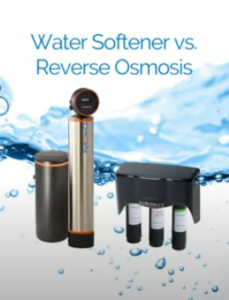
Water quality is a crucial consideration for every household, impacting everything from the taste of drinking water to the longevity of plumbing fixtures. Two common solutions to improve water quality are water softeners and reverse osmosis systems. While both aim to enhance water purity, they serve distinct purposes and are suitable for different water quality issues. Let’s delve into the differences between these two systems to help you determine which might be best for your needs.
Water Softeners: Tackling Hard Water Woes
What is Hard Water?
Hard water is water that contains high levels of minerals such as calcium and magnesium. While not harmful to health, it can cause issues like scale buildup in pipes, appliances, and water-using devices, as well as soap scum in bathrooms.
How Water Softeners Work
Water softeners are designed to combat the effects of hard water through a process called ion exchange. Inside a water softener tank, resin beads attract and trap calcium and magnesium ions, exchanging them for sodium or potassium ions. This process effectively softens the water by reducing the concentration of these minerals.
Benefits of Water Softeners:
– Reduced Scale Buildup: Helps extend the lifespan of plumbing and appliances by preventing mineral deposits.
– Softer Skin and Hair: Soft water is gentler on skin and hair, often leaving them feeling smoother.
– Improved Soap Efficiency: Soap lathers better in soft water, reducing the amount needed for cleaning tasks.
Limitations:
– Does Not Remove Contaminants: While effective against hardness minerals, water softeners do not remove other contaminants like chemicals or microorganisms.
Reverse Osmosis Systems: Purifying Water to Its Core
What is Reverse Osmosis?
Reverse osmosis (RO) is a water purification process that uses a semi-permeable membrane to remove ions, molecules, and larger particles from water. It is effective in eliminating a wide range of contaminants, making it a popular choice for improving overall water quality.
How Reverse Osmosis Works:
In an RO system, water is forced through a membrane under pressure, which blocks contaminants while allowing pure water to pass through. The result is purified water that is free from most impurities.
Benefits of Reverse Osmosis Systems:
– Comprehensive Contaminant Removal: Removes contaminants such as lead, arsenic, nitrates, pesticides, and more.
– Improved Taste and Odor: Produces clean, great-tasting water for drinking and cooking.
– Versatility: Can be installed under the sink or as a whole-house system, depending on needs.
Limitations:
– Wastewater Generation: RO systems produce wastewater as a byproduct of the purification process.
– Ongoing Maintenance: Requires periodic filter replacements and maintenance to ensure optimal performance.
Choosing the Right System for Your Home
When deciding between a water softener and a reverse osmosis system, consider the primary issues with your water quality. If your main concern is hard water causing scaling issues, a water softener is likely the best solution. On the other hand, if you’re looking to improve overall water purity by removing contaminants, a reverse osmosis system is more suitable.
In some cases, especially where both hard water and contaminants are present, combining both systems might be necessary. Consulting with a water treatment professional can provide further insights based on your specific water quality tests and household needs.
Investing in the right water treatment system can significantly enhance your quality of life and the longevity of your plumbing infrastructure. Whether you opt for a water softener or a reverse osmosis system, the goal remains the same: cleaner, safer, and better-tasting water for you and your family.
